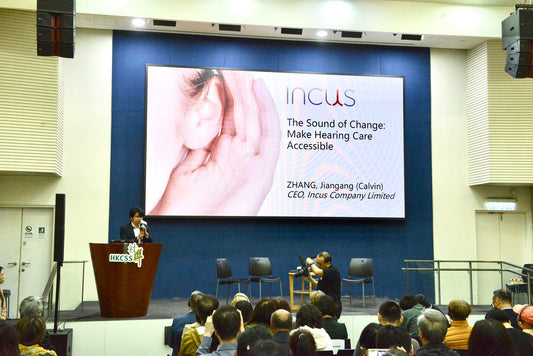What Is An Over-The-Counter (OTC) Hearing Aid?
Over-the-counter (OTC) hearing aids are purchased without a prescription (as opposed to traditional prescription hearing aids).
In the United States, hearing aids required a prescription (or a waiver) until 2022. To make hearing aids more accessible to the population (average price is US$ 4,600/pair), the US Food and Drug Administration (FDA) established a category of over-the-counter hearing aids for adults with perceived mild to moderate hearing loss.
The new rule came into effect in October 2022.
The OTC Hearing Aid Act And What It Means For Hard-Of-Hearing In The United States and Beyond
The OTC hearing aid rule will have widespread impacts on consumers worldwide, despite its legal effect being limited to the United States. In short, the new rule is a first-of-its-kind performance standard, and will make hearing aids cheaper and more accessible, and stimulate innovation.
How the OTC Hearing Aid Rule Creates A Performance Standard
While hearing aids had already been available without prescription in many countries, there were no standards defining what features a good OTC hearing device should include or which technical specifications it should have.
Among other, the OTC hearing aid rule specifies output limits, electroacoustic performance limits and design requirements.
These requirements raise the bar, which means consumers will benefit from better and safer products being available in the market.
How The OTC Hearing Aid Rule Will Stimulate Innovation
Hearing aids have traditionally been sold through offline channels like hearing aid dispensers and audiologists. These channels were almost exclusively occupied by the Big Five. The Big Five are corporations accounting for up to 99% of all hearing aids sold across a multitude of brands they own.
The traditional channels would sell their products either because they were outright owned by the Big Five, or because their brands could charge the highest premiums, resulting in high margins for the hearing aid dispensers.
This means the traditional channels would not necessarily sell the best products. And if new entrants made better products, the Big Five would deploy various tactics to throttle their access to channels and limit their success in the market.
Now that hearing aids can be sold over-the-counter, it means they can be sold in big box retailers and over the internet. Through such channels it is finally possible for innovative products to reach the consumer.
How The OTC Hearing Aid Rule Will Result In Cheaper and More Accessible Hearing aids
The OTC hearing aid rule will result in cheaper hearing aids through two main mechanisms: Unbundling and competition.
Unbundling: Hearing aids were traditionally sold in a bundle of product + services. The services would for instance include follow-up visits to make adjustments to the device. As a customer, you would pay upfront for the whole package, which is how we arrived at average prices of US$ 4,600/pair.
Unfortunately, millions of consumers have overpaid because of these bundling tactics.
Think about it: As a consumer, what monetary value would you attach to the services? Would you even use the services you pre-paid for?
And would the hearing aid dispenser not have higher profits if you did NOT visit often?
It is similar to how gyms’ business models rely on overly optimistic consumers with new year resolutions signing up for annual packages - if all the gym members actually showed up, the gym would not be able to accommodate them!
Now that hearing aids are available over-the-counter, consumers can purchase the devices they want unbundled and later seek professional services on a needs-basis.
Competition: As it is now viable for new entrants to reach the consumer, both incumbents and innovators must set reasonable prices and offer better products to be competitive in the market.
How The OTC Hearing Aid Rule Will Impact Consumers Outside The United States of America
Consumers worldwide should now demand that OTC products they purchase can meet the standard created by the FDA.
Although the rule came into force as recently as October 2022, there are already products in the market that can meet the requirements.
And although the rule is only effective within the US, some innovators have already made their OTC devices available in other regions.
In Hong Kong, for example, the sale of hearing aids does not require a prescription.
Are There Any Products In Hong Kong That Meet The FDA’s OTC Hearing Aid Requirements?
As mentioned, the FDA’s OTC hearing aid requirements introduce, among other, requirements for output limits, electroacoustic performance limits and design requirements.
Incus, a Hong Kong local hearing aid brand spun-off from The Hong Kong University of Science and Technology, has already launched a product satisfying those requirements: Kite 2.

Here are the detailed requirements and how Incus’ Kite 2 meets them:
Output Limits
Because OTC hearing aids are intended for adults with perceived mild to moderate hearing loss and can be set up without a hearing instrument specialist, the FDA has set upper limits to how loud the sounds they output can be.
Depending on the technology level of the OTC hearing aid, there are two alternative version of the limit:
(1) General output limit. An OTC hearing aid shall not exceed an output limit of 111 dB SPL at any frequency except as provided in paragraph (d)(2) of this section.
(2) Output limit for a device with activated input-controlled compression. An OTC hearing aid that has input controlled compression activated shall not exceed an output limit of 117 dB SPL at any frequency.
Incus’ Kite 2 features activated input-controlled compression, and its maximum output level is limited to 105 dB SPL, which is well below 117 dB SPL.
Electroacoustic Performance Limits
Simply put, the FDA set electroacoustic performance limits to ensure that OTC hearing aids have acceptable sound quality.
Electroacoustic performance limit 1: Output distortion control limits. Test the output distortion of the OTC hearing aid as follows to ensure that it does not exceed the limit specified in paragraphs (e)(1)(i) through (iii) of this section.
(i) The total harmonic distortion plus noise shall not exceed 5 percent for output levels within one of the following sets of levels, depending on the test method:
(A) Using sine wave-based testing, measure at 70 dB SPL and 100 dB SPL;
Or
(B) Using a 500-hertz (Hz) one-third octave pulsed-noise signal, measure at 67 dB SPL and 97 dB SPL.
(ii) You must measure the total harmonic distortion using a 500-Hz input tone with an analyzer that has a bandwidth at least as wide as the frequency limits of the OTC hearing aid.
(iii) You must measure the output distortion at the OTC hearing aid’s maximum volume and the input sound level to the OTC hearing aid adjusted to produce the required outputs
Distortion is a common measure for sound quality. It refers to the phenomenon where the output signal contains additional frequency components that are not present in the original signal.
Distortion degrades the sound quality, and when there is distortion it will will sound unnatural or noisy.
Distortion can be caused by the hearing aid’s electronic components or the audio signal processing algorithms used.
We measured Kite 2’s harmonic distortion to be less than 1% - significantly lower than the upper limit of 5%.
Electroacoustic performance limit 2: Self-generated noise level limits. Self-generated noise shall not exceed 32 dBA. You must disable any methods that artificially lower the apparent noise floor for the measurement. Such methods would include but are not limited to auto-muting and downward expansion.
Electric currents pass through electronic devices, and these translate into noise. If the internal noise in a hearing aid is too loud, it will interfere with the wearer’s ability to hear clearly. The FDA has set a limit of 32 dBA.
We measured the equivalent input noise of Kite 2 to be 27 dBA - 5 dBA lower than the upper limit.
Electroacoustic performance limit 3: Latency. Latency shall not exceed 15 ms. You must measure the latency with a method that is accurate and repeatable to within 1.5 ms.
Latency is the time it takes from when an external sound reaches the hearing aid until the processed sound is output into the wearer’s ear.
If the latency is too long, the wearer will notice that there is a delay between when a person moves their mouth until they can hear the speech. The FDA states that 4 out of 9 people can notice a delay of 25 ms.
The delay could also be noticed as an echo, and it could even degrade the sound quality.
Some latency is necessary, however, because the hearing aid has to process the sounds in sophisticated ways to reduce noise and make the speech more clear to the wearer.
The FDA requires that this delay is no longer than 15ms (0.015s).
We tested the latency of Kite 2, which clocked in at about 8ms - safely within the FDA’s limit.
Electroacoustic performance limit 4: Frequency response bandwidth. The lower cutoff frequency shall extend to 250 Hz or below, and the upper cutoff frequency shall extend to 5 kHz or greater. You must measure the frequency response bandwidth as specified in the Method for clause 4.1 in ANSI/CTA–2051:2017.
While humans can hear up to 20,000 Hz (20kHz), the most important frequencies are between 250 Hz and 5kHz. The FDA therefore requires that OTC hearing aids at least cover this range.
We measured the bandwidth of Kite 2 and found it is 200 Hz to 6kHz, which means it covers the required range (and then some!).
Electroacoustic performance limit 5: Frequency response smoothness. No single peak in the one-third-octave frequency response shall exceed 12 dB relative to the average levels of the onethird- octave bands, two-thirds octave above and below the peak. You must measure the frequency response smoothness using values for a diffuse field and the corrected one-third-octave frequency insertion response as specified in the Method for clause 4.1 in ANSI/CTA–2051:2017.
The FDA requires that the sound from an OTC hearing aid is smooth in the sense that there are no sudden peaks or dips in loudness across the frequency range.
This requirement is related to how natural the hearing aid will sound, and how comfortable it will be to listen to.
We measured Kite 2’s frequency response and confirmed that it is smooth, indicating the algorithms are well-engineered and that the device provides clear, natural sound.
Electroacoustic performance limit 6: Acoustic coupler choice. Where applicable, use one of the following acoustic couplers to measure electroacoustic performance:
(i) When compatible with the device design, a 2-cubic centimeter (cm3) acoustic coupler; or
(ii) When a 2-cm3 acoustic coupler is not compatible with the device design, an acoustic coupler that is a scientifically valid and technically equivalent alternative. You must document the rationale for using an alternative acoustic coupler.
When testing Kite 2, we used a so-called 2cc coupler. This is a standard piece of equipment which helps ensure that measurements are repeatable and accurate.
Design Requirements
The FDA has also formulated several requirements for the physical design of an OTC hearing aid.
Design requirement 1: Insertion depth. The design of an OTC hearing aid shall limit the insertion of the most medial component so that, when inserted, the component is reasonably expected to remain at least 10 millimeters (mm) from the tympanic membrane.
This requirement is designed to prevent damage caused by objects touching the eardrum (tympanic membrane).
Traditional receiver-in-canal (RIC) hearing aids are inserted deeply into the ear canal. The FDA requires that nothing comes closer than 10 mm from the eardrum.
Kite 2’s earpiece is similar to that of a consumer earphone. The silicon eartips are not deeply inserted into the ear canal so there is no risk of the eartips reaching the eardrum.

Design requirement 2: Use of atraumatic materials. The material for the eartip of an OTC hearing aid shall be atraumatic.
Kite 2’s eartips are ear-conforming and skin-friendly, made from soft silicone, and they have passed biocompatibility testing by a third-party laboratory to ensure they do not cause adverse reactions.

Kite 2's eartips are skin-friendly and passed biocompatibility tests by a third-party laboratory
Design requirement 3: Proper physical fit. The design of an OTC hearing aid shall enable consumers to readily achieve a safe, customized, acoustically favorable, and comfortable physical fit in the ear canal and/or external ear.
Kite 2 comes with three sizes of eartips, allowing the wearer to find a comfortable physical fit. The eartips let air pressure escape via a proprietary venting mechanism to avoid a stuffed feeling while lowering ambient noise, prevenint acoustic feedback and yielding rich sound across the range.
Design requirement 4: Tools, tests, or software. The OTC hearing aid shall, through tools, tests, or software, permit a lay user to control the device and customize it to the user’s hearing needs.
It is important that hearing devices are adjustable to the user’s unique hearing needs. For example, if someone suffers from high-frequency hearing loss, they should receive more amplification at those frequencies, rather than a flat boost across the whole range.
There are various ways to let the wearer customize the sounds from their hearing device. Incus has opted for perhaps the ideal method: An app-based hearing test.
The device is set up by completing a hearing test in the accompanying app Yinbei.
After the hearing test, sounds are personalised to the wearer’s unique profile.
Kite 2 will remember the hearing test result, so it is optional to use the app after the initial setup.

Design requirement 5: User-adjustable volume control. The OTC hearing aid shall have a user adjustable volume control.
Wearers will have different preferences for how loud they like the volume, and the preference will even vary across different scenarios.
In some cases, the volume could also be uncomfortably loud.
Therefore, the FDA requires that OTC hearing aids include volume controls that the user can operate by themselves according to their preference.

Kite 2 has physical buttons for volume control
Kite 2 has volume control buttons with tactile indicators on the device itself. This lets the wearer distinguish between the volume up/down buttons just by feeling the symbols with their finger before pressing.
Design requirement 6: Adequate reprocessing. If the OTC hearing aid is used or rebuilt, it must be adequately reprocessed for the next user prior to sale.
Due to hygiene issues, the FDA has requirements for how returned items should be handled before they are resold.
Incus’ customer service was asked how they handle returned items. They explained that the devices are disinfected, the software is reset to factory settings, and eligible devices are repackaged in sealed packaging before resale. Refurbished items are advertised as such.
Conclusion
Over-the-counter (OTC) hearing aids can be purchased without prescription and are intended for use by adults with perceived mild to moderate hearing loss. The OTC rule is effective within the US, but hard-of-hearing worldwide will benefit from this first-of-its-kind performance standard, which will make hearing aids cheaper and more accessible, and stimulate innovation.
With the new rule, the FDA has defined requirements for output limits, electroacoustic performance limits and design requirements, among other. Already, there are products available in the market meeting these requirements, such as Kite 2 by Incus.



